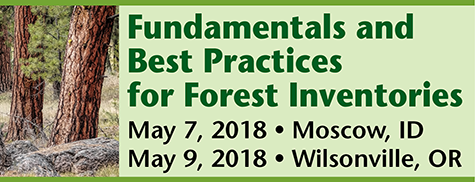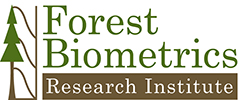Fundamentals and Best Practices for Forest Inventories

Agenda
Location: Moscow, ID or Wilsonville, OR
Co-sponsored by:

8:00 Building Blocks of Sound Inventory Design
- What is a working forest inventory? The evolution over 30 years from strata averages and yield tables to individual stand structures within strata.
- Why you should be cruising for inventory versus harvest. Your cruising objective is to capture silvicultural growth capacity and setup the ability to re-merchandize as markets change.
8:30 Sample Designs – Strata
- Stratifying the whole forest – What are the right classifications and levels of strata?
- Breaking the strata into unique stand polygons – Why we need unique stand identification.
- Sampling stands within each strata for cruising – Getting the right distribution, intensity and frequency of sampling and working with riparian buffers and setasides.
10:00 BREAK
10:20 Sample Design – Plots
- Distributing your plots across the entire stand – Why this makes a difference.
- Including small tree frequencies to define density.
- How large tree frequencies define silvicultural options and asset values.
- Defining clumpiness with systematic spatial plot patterns to quantify the impact on yield capacity.
- Determining the right plot frequency and distribution within each stand.
Noon LUNCH
1:00 Sample Design – Trees
- Sampling all trees of all species and sizes within each stand makes a difference.
- Applying a combination of prism-sweep and fixed area plot designs for sampling.
- How to use a 1/20th acre fixed area circular plot for standing dead trees.
- Sampling down woody material using a minimum 100-foot transect line.
A. Tally frequencies by species and size class, never by species alone.
B. When and why to record tree condition and vigor class in cruise design.
C. Methods for selecting large trees height samples – why this makes a difference.
D. Estimating live crown length and percent defect in large trees.
E. When and how to measure taper.
F. When and why to measure age.
2:00 BREAK
2:20 Cruise Compilation Methods
- Compiling each stand cruise versus compiling by strata – within and between stands.
- Height estimation methods – why tree heights vary with silviculture.
3:30 Expanding the Cruise to Un-sampled Stands
- Assigning a stand structure to un-sampled stands from an average tree list generated from sampled stands – when and why these methods are important to understand and use.
- Do’s and don’ts of cruise expansions – methods, timing, frequency and assumptions.
4:15 Year-end Updates and Reporting – Getting the Sequence and Components Right
- Incorporating all new harvest units, deletions, acquisitions and boundary adjustments in a GIS stand polygon layer.
- Updating the GIS road network and road class buffer widths.
- Updating the GIS stream courses and riparian buffer widths.
- Updating all administrative, silvicultural and operational costs.
- Running reports for year-end harvest volume and value reports.
- Growing stands for one year from the previous year for annual growth reporting.
- Updating the inventory with all new cruises from all sampled stands within current year – identifying the actual impact of new information.
- Producing forest-wide reports of new current standing forest inventory.
5:00 Adjourn
About the Conference
Workshop LocationsThe May 7, Moscow session will be held at the Best Western Plus University Inn, 1516 Pullman Rd, Moscow, ID.
The May 9, Wilsonville session will be held at the Holiday Inn Portland South, 25425 SW 95th Ave, Wilsonville, OR.
A Free Feature With Your Workshop Registration
All workshop attendees will be offered free post-workshop one-on-one consultation with the session speakers either over the phone, via email or remote desktop sharing. These workshops will cover many topics and if you get back to your office and have questions about any of the workshop content, the session speakers will provide one-on-one consultation on any inventory issue. This offer will expire on July 31, 2018 and the session speakers reserve the right to limit the amount of consultation.

